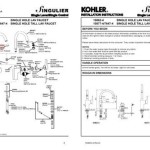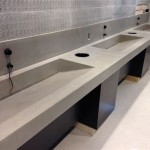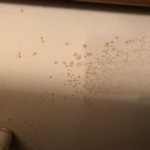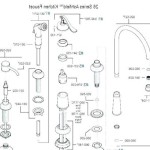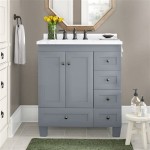Moen Bathroom Faucets: A Comprehensive Guide to Leak Repair
Moen bathroom faucets are a prevalent fixture in many homes, recognized for their durability and diverse designs. However, like all plumbing components, they are susceptible to leaks over time. Identifying and addressing these leaks promptly is crucial to prevent water damage, conserve water, and avoid costly repairs. This article provides a detailed guide on how to diagnose and repair common Moen bathroom faucet leaks.
Before commencing any repair work on a Moen faucet, safety precautions are paramount. The initial step involves turning off the water supply to the faucet. Typically, shut-off valves are located beneath the sink. If these valves are not present or are malfunctioning, the main water supply to the house must be shut off. It is also prudent to plug the sink drain to prevent small parts from falling into the drainpipe.
The necessary tools for Moen faucet repair include a screwdriver set (both Phillips head and flathead), an adjustable wrench, a set of Allen wrenches, pliers, penetrating oil, white vinegar, plumber's grease, and replacement parts specific to the Moen faucet model being repaired. Having these tools readily available will streamline the repair process.
Identifying the Source of the Leak
Accurately identifying the source of the leak is the first critical step in the repair process. Moen bathroom faucets can leak from several locations, each indicating a different underlying problem. Common leak locations include:
Around the base of the faucet: A leak at the base of the faucet often indicates a problem with the O-rings or the mounting hardware. These components can degrade over time, causing water to seep through the seal between the faucet and the sink.
From the spout: A dripping spout is frequently caused by a worn-out cartridge or a damaged valve seat. The cartridge is responsible for controlling the flow of water, and if it is damaged, it may not seal properly, leading to a constant drip.
Under the handle: A leak under the handle often points to a worn-out O-ring or cartridge stem seal. These small rubber components can dry out and crack over time, allowing water to escape.
From the faucet connections: Leaks at the connections between the faucet and the water supply lines usually indicate loose connections or damaged supply lines. Over time, these connections can loosen due to vibrations and pressure changes.
To pinpoint the exact location of the leak, thoroughly inspect the faucet while it is running. Use a flashlight to examine hard-to-reach areas and observe where the water is originating.
Repairing a Leaking Cartridge Faucet
Cartridge faucets are a common type of Moen bathroom faucet, and leaks in these faucets are often attributed to a faulty cartridge. The following steps outline the process for replacing a Moen cartridge:
Shut off the water supply: As previously mentioned, turning off the water supply is essential before beginning any plumbing repair.
Remove the handle: The handle is typically secured with a screw, which may be concealed by a decorative cap. Use a screwdriver to remove the screw and detach the handle. Some handles require a specific Moen handle puller tool.
Remove the handle adapter or escutcheon: Depending on the faucet model, there may be a handle adapter or escutcheon covering the cartridge. Remove this component to expose the cartridge retaining clip.
Remove the retaining clip: The retaining clip holds the cartridge in place. Use pliers or a small screwdriver to carefully remove the clip. Be cautious not to damage the clip during removal.
Remove the cartridge: Once the retaining clip is removed, the cartridge can be pulled straight out. Moen cartridges can be notoriously difficult to remove, especially if they have been in place for an extended period. A cartridge puller tool is often necessary. If the cartridge is stuck, apply penetrating oil around the cartridge and allow it to sit for several minutes before attempting to remove it. Using pliers, grip the stem of the cartridge and gently twist and pull until the cartridge is free.
Clean the valve body: After removing the cartridge, inspect the valve body for any debris or corrosion. Use a soft cloth or brush to clean the valve body thoroughly. White vinegar can be used to dissolve mineral deposits.
Install the new cartridge: Before installing the new cartridge, apply a thin layer of plumber's grease to the O-rings on the cartridge. This will help to ensure a proper seal and facilitate future removal. Align the new cartridge with the valve body and gently push it into place until it is fully seated.
Reinstall the retaining clip: Secure the new cartridge by reinstalling the retaining clip. Ensure that the clip is properly positioned and fully engaged.
Reassemble the faucet: Reattach the handle adapter or escutcheon, the handle, and the handle screw. Tighten the screw securely, but avoid over-tightening.
Turn on the water supply: Slowly turn on the water supply and check for leaks around the base of the cartridge and the handle. If any leaks are present, re-examine the cartridge installation and ensure that all components are properly seated and tightened.
Addressing Leaks at the Base of the Faucet
Leaks occurring at the base of the faucet usually involve the O-rings or the mounting hardware. The following steps outline the process for addressing these leaks:
Shut off the water supply: Ensure the water supply is completely shut off before proceeding.
Disconnect the water supply lines: Disconnect the hot and cold water supply lines from the faucet. Use an adjustable wrench to loosen the connections. Have a bucket handy to catch any residual water in the lines.
Loosen the mounting nuts: The faucet is typically secured to the sink with mounting nuts located underneath the sink. Use an adjustable wrench to loosen these nuts until the faucet can be removed.
Remove the faucet: Carefully lift the faucet from the sink. Inspect the O-rings and the mounting hardware for signs of wear or damage. The O-rings are usually located on the base of the faucet and may appear cracked, flattened, or brittle.
Replace the O-rings: If the O-rings are damaged, replace them with new O-rings of the same size and type. Apply a thin layer of plumber's grease to the new O-rings before installation.
Inspect and replace the mounting hardware: Examine the mounting hardware, including the washers and nuts, for any signs of corrosion or damage. Replace any damaged components with new hardware.
Reinstall the faucet: Place the faucet back onto the sink, ensuring that it is properly aligned. Secure the faucet by tightening the mounting nuts underneath the sink. Avoid over-tightening the nuts, as this can damage the sink or the faucet.
Reconnect the water supply lines: Reconnect the hot and cold water supply lines to the faucet. Ensure that the connections are tight, but avoid over-tightening.
Turn on the water supply: Slowly turn on the water supply and check for leaks around the base of the faucet and the water supply connections. If any leaks are present, re-examine the installation and ensure that all components are properly seated and tightened.
Repairing Leaks from Faucet Connections
Leaks emanating from the faucet connections typically stem from loose connections or damaged supply lines. The following steps detail the procedure for addressing these leaks:
Shut off the water supply: Turn off the water supply before commencing any work on the water lines.
Inspect the connections: Thoroughly inspect the connections between the faucet and the water supply lines for signs of leaks. Check for water droplets or mineral buildup around the connections.
Tighten the connections: Use an adjustable wrench to tighten the connections. Tighten the nuts securely, but avoid over-tightening, as this can damage the supply lines or the faucet.
Replace the supply lines: If tightening the connections does not resolve the leak, the supply lines may be damaged and require replacement. Disconnect the old supply lines from the faucet and the water shut-off valves. Install new supply lines of the same size and type. Ensure that the connections are tight, but avoid over-tightening.
Check the compression fittings: If the supply lines utilize compression fittings, inspect the fittings for any signs of damage or corrosion. If necessary, disassemble the compression fittings and replace the compression sleeves and nuts.
Apply Teflon tape: Before reconnecting the supply lines, apply Teflon tape to the threads of the connections. This will help to create a watertight seal.
Turn on the water supply: Slowly turn on the water supply and check for leaks around the connections. If any leaks are present, re-examine the installation and ensure that all components are properly seated and tightened.
Regular maintenance is essential for preventing leaks and prolonging the lifespan of Moen bathroom faucets. Periodically inspecting the faucet for signs of leaks and addressing minor issues promptly can prevent more significant problems from developing. Cleaning the faucet regularly and avoiding abrasive cleaners can help to maintain its finish and prevent corrosion. If a leak persists despite following these repair steps, consult a qualified plumber for assistance.

How To Fix A Dripping Moen Faucet Howtolou Com

How To Replace Repair A Leaky Moen Cartridge In Bathroom Set Of Faucets Single Lever Tips

How To Repair Moen Bathroom Faucet Dripping Water Cartridge Removal Replace Single Lever

Easy Moen Bathroom Faucet Drip Repair

How To Fix A Leaking Faucet Without In The Handle Moen

How To Fix A Leaky Faucet Kitchen Repair Moen Bathroom Faucets

Moen Bathroom Faucet Repair 1225

Fix A Leaky Moen Bathroom Faucet In Less Than 15 Minutes

How To Repair Remove Replace A Leaking Moen Shower Faucet Cartridge Valve With Single Knob 1225

How To Fix A Leaking Bathroom Faucet Quit That Drip
Related Posts


